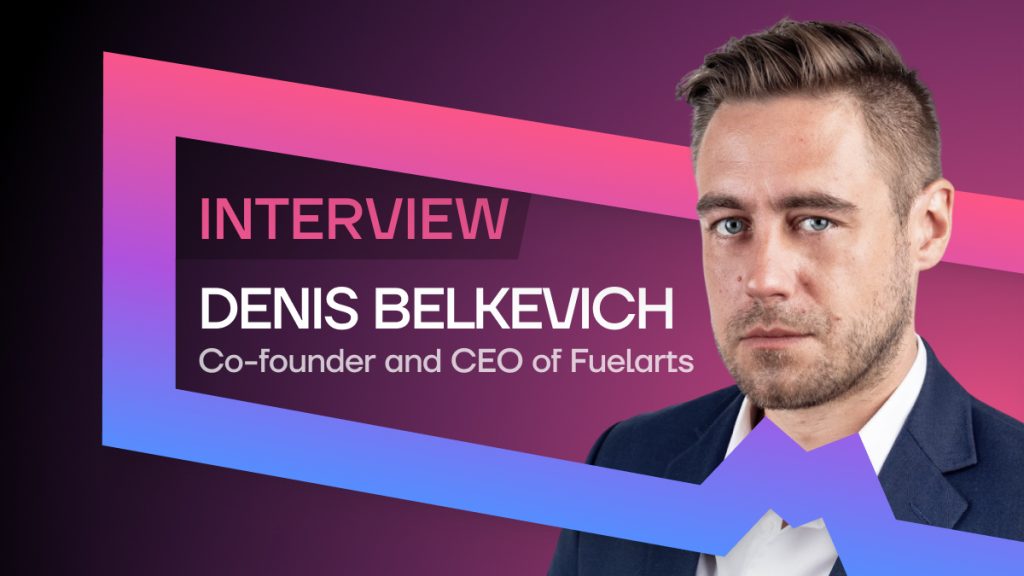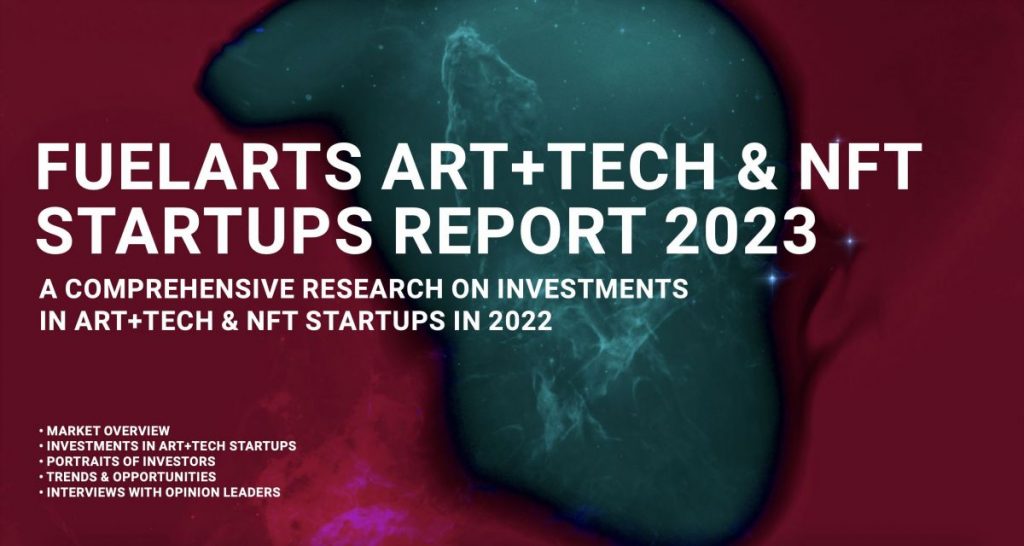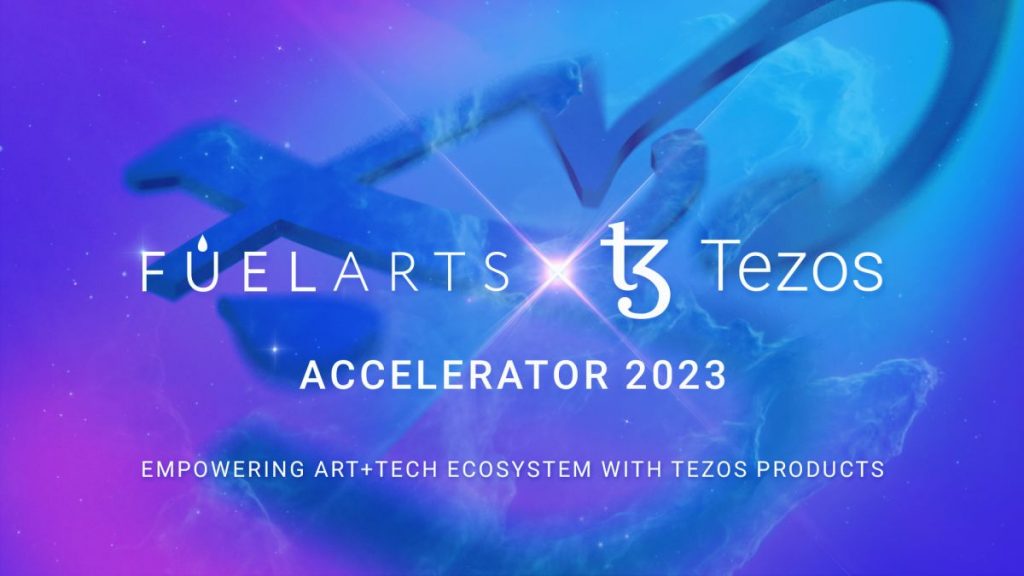Denis Belkevich, who leads Fuelarts, offers valuable insights about investment dynamics and details surrounding the company's NFT report.
In Brief
CEO Denis Belkevich of Fuelarts discusses present investment tendencies, the impact of blockchain technology on the art sector, and the company's future strategies.
On March 14, Fuelarts unveiled its latest report, marking its third edition. Art+Tech & NFT Startups Report This comprehensive report provides insights into market trends, investment opportunities, and includes interviews with key influencers in the art world.

Denis Belkevich engaged in a dialogue with Metaverse Post, where he highlighted his role as an art economist and professional advisor with expertise in both tangible and digital assets. Currently, he is also contributing as a lecturer at Sotheby's Institute of Art in New York City.
Denis Belkevich, alongside Roxanna Zarnegar, the former COO of Christie’s Americas, established Fuelarts in 2019. The organization comprises three main divisions: Fuelarts Insights, Fuelarts Capital, and Fuelarts Accelerator.
On March 14, the platform made public its third edition of the report. Art+Tech & NFT Startups Report This report is an in-depth exploration that spans market analysis, investment insights, trending opportunities, as well as expert interviews.
In his interview, Denis Belkevich shared his perspective on ongoing investment trends, providing a deeper understanding of the intricate relationship between the web3 space and the art market. He elaborates on how blockchain influences the sector and discusses the strategic vision for Fuelarts.
In what ways do you see blockchain impacting the art market today, and how might this evolve in the future?
Blockchain technology has the potential to transform the art market in various aspects. It serves as a digital ledger, ensuring the secure storage of information, enhances the decentralization of contracts, and simplifies international transactions. Nevertheless, the legislative landscape surrounding cryptocurrencies has failed to keep pace with the rapid advancements made by Art+Tech start-ups, stalling market evolution. Currently, the primary operational functions within the art sector using blockchain involve detailing origins and tracking art transactions. However, the automatic royalty payment system is not yet fully effective, as it heavily relies on well-crafted smart contracts and the sales platforms' willingness to share profits with artists. The ultimate goal for many collectors remains a seamless payment system enabling quick purchasing of art globally or informal peer-to-peer transactions devoid of intermediaries, which is still under development.
Furthermore, the integration of blockchain technology in the art market has faced skepticism from veteran collectors who prefer maintaining confidentiality in their transactions, leading to reluctance in revealing collection details. This has led to the emergence of options such as 'private blockchains' or 'blockchains with tailored public access'—concepts once shunned by the crypto community. Additionally, older collectors often resist the idea of fractional ownership of artworks, believing that complete ownership is paramount. However, a shift is evident with the rise of Gen Z and millennials in the collector space, who are more inclined to embrace shared ownership, mitigating risks, and fostering a sense of community.
What investment trends are emerging in web3 art and technology start-ups?
In the past eighteen months, we’ve seen a dramatic evolution in investment priorities within the Art+Tech field. The year 2021 was characterized by a surge in funding for marketplace platforms focusing on NFTs. However, by the first half of 2022, the market experienced saturation, driving users to seek higher quality, curated art. Consequently, investments began favoring creative entities producing content, particularly startups with the label 'labs', like design studios and agencies generating NFT collections or developing metaverse projects.
Entering the latter half of 2022, interest pivoted towards analytics startups. Platforms specializing in creating NFT indices, assessing existing collectors' portfolios, and relaying market insights gained prominence. Following the speculative hype surrounding NFTs, the market came to recognize that digital asset analytics would be essential for future growth—a promising indication as investors see long-term potential in NFTs. If there’s no interest, why would any investor back indices that aren't set to launch until 2024?
As we kick off 2023, there's a notable surge in investments directed towards Art+Tech startups leveraging AI technologies. This trend encompasses every facet of the value chain, from creation to trading, management, and analytics. AI is currently aiding in the generation of art (think generative art), but the future holds promise for AI’s capabilities in managing collections or guiding an artist’s career, as well as optimizing the timing for acquiring new pieces or selling existing ones. Of particular note is a heightened interest in AI-driven SaaS solutions that can seamlessly integrate with various tech products to meet specific startup needs.

How do you anticipate the investment trends of 2022 will evolve through 2023?
Despite experiencing a downturn, 2022 was a noteworthy year for the Art+Tech landscape, smashing multiple historical investment records. Cumulatively, funding for infrastructure startups reached an impressive $3.48 billion, representing nearly half of all investments in the Art+Tech sector since 2000. In total, 242 startups secured funding, which accounts for 28.6% of the total number of companies funded since 2000, and for the first time ever, nine startups collectively received over $100 million in a single year.
However, recent economic conditions have clearly impacted how investors behave. The percentage of startups receiving initial funding during their inception year significantly declined in 2022, with many investors gravitating towards startups they previously supported in earlier financing rounds.
Caution characterized much of the investment landscape in 2022, with 81.9% of the 854 investors active in the Art+Tech sector opting to put their money into a single entity. This protective stance is understandable. While investors can maneuver through both thriving and declining markets, during times of uncertainty, they often adopt a wait-and-watch approach. As a result, only $1.7 billion of the over $24 billion raised by 34 investment funds found its way into web3 startups. However, there’s optimism that the climate will improve in 2023, potentially reviving planned transactions.
In the meantime, throughout 2023, investors will be observing how startups navigate these challenging times in order to pinpoint the most resilient players in the market, both from a business perspective and in terms of their adaptability to stressors. Moves to negotiate mergers and acquisitions at discounted rates may also persist, allowing investors to acquire startups on the brink of failure for minimal prices. With a dip in general investment interest, support for startups may intensify, and targeted funding from major strategists and blockchain entities could prove to be the most fruitful method for raising capital.
What does the near future hold for the NFT marketplace?
In my view, the NFT model is just scratching the surface, realizing perhaps only about 20% of its full potential. There’s a vast realm of possibilities concerning self-executing smart contracts, practical applications, and connections with physical assets that remain untapped. Back in 2021, the market leaned heavily on NFTs for their speculative attributes; however, this approach poses risks of causing eventual fatigue regarding NFTs' limitations. Thus, a rebranding of sorts might be necessary, shifting the narrative around digital art towards new definitions. Generative Art or AI Art.
Nevertheless, initiatives are underway to preserve the status of NFTs in curated and open platforms, where collectors increasingly demand quality artistry and compelling narratives from creators. There’s also a rise in the development of functional NFTs that provide tangible benefits, such as discounts and loyalty rewards. New platforms are emerging, aiming to breathe renewed life into NFTs to help create secondary licensing markets without the challenges associated with reselling.
We are likely to see an upsurge in complex NFTs that merge elements from fine arts, music, cinema, comics, and fashion into singular assets in the coming years. Additionally, ownership trends are shifting, as it becomes commonplace for NFT holders to request physical renditions of their digital creations, highlighting the fact that we still exist in tangible spaces, filled with physical walls, even as we engage primarily with our screens.
Why should individuals continue to invest in digital art amidst a bear market?
I have four compelling reasons for this inquiry, allowing individuals to align their choices with their personal values:
- The most revolutionary artists tend to emerge during bear markets, potentially leading to significant impacts in the future.
- Quality digital artwork is available at discounted rates right now.
- By investing in digital art, collectors actively support the market, encouraging others to take notice and potentially kick-starting a new growth cycle.
- Every artwork serves as a snapshot of its time of creation, reflecting both the era and our current existence—the most precious commodity we possess is time itself.
What is your perspective on blue-chip NFT projects such as BAYC, Doodles, Azuki, etc.? Do these hold artistic value? Why or why not?
In my view, intricate NFT initiatives such as BAYC represent a counter-movement to the restrictive practices seen in the conventional art world, where top auction houses and galleries often create a barrier that feels exclusive and club-like, making it hard for the average buyer to engage. This dynamic has spawned a new wave of young collectors who outright reject these elitist values and have established their own standards and communities. Collecting NFTs, in this light, transcends mere ownership; it evolves into a shared experience where owners resonate with common values. So, when posed with the question of whether collections like BAYC, Doodles, and Azuki can be classified as art, my response is affirmative. However, I would emphasize that this classification should be framed around the visionary strategies of their creators and the social connections among their owners, placing artistic merit in a secondary position.
At present, BAYC, masterminded by Yuga Labs, stands out as a pioneer in strategic innovation; it can be described as an archetype of a 'startup strategist.' Following an impressive $450 million investment, Yuga Labs secured ownership of iconic collections such as CryptoPunks, WENEW, and Meebits, while continually funneling resources into audacious ideas and tech teams. They are busy crafting an entire ecosystem for NFT holders, bridging both digital and physical realms to offer meaningful, tangible benefits. Furthermore, they are actively marketing their franchise while ensuring that third-party products and services uphold high standards. The key distinction between BAYC and Doodles lies in the scale of their investment: BAYC secured a hefty $450 million, while Doodles managed to raise just $54 million.
What are your thoughts on Ryder Ripps’ legal battle with Yuga Labs and the broader implications of intellectual property in this space?
It's a common misconception that the laws governing physical artwork copyright operate seamlessly. The Berne Convention from 1886 set the groundwork for global copyright norms that, notably, also pertain to NFTs as interpreted by legal experts. Yet, the legal framework feels outdated. Moreover, there's a significant lack of global consensus, as heavyweights in the art sector like the United States, the United Kingdom, and China have not signed onto the 2001 European Parliament Directive, which addresses resale royalties.
Consequently, NFT owners are hindered when it comes to fractionalizing their assets for sale; they must obtain author consent to avoid infringing on the 'integrity of the work.' The absence of consistent legislation results in a scenario where buyers in some jurisdictions might view certain NFT activities as legal, even though they lack ethical consideration. For this reason, NFT creators are urged to secure their works across three intellectual property dimensions: copyright (for the artwork), design patent (for logos), and trademark rights (for brand names).
Despite these hurdles, disputes between NFT creators and owners who misappropriate images are commonplace. Yet, only cases involving copyright holders with the necessary financial resources for court battles tend to gain public attention. The situation mirrors the collapse of the FTX exchange, serving as a wake-up call that underscores the imperative to enhance the legal landscape and reassures digital asset owners that their holdings are under scrutiny. The more high-profile cases that result in penalties, the less likely unscrupulous actors are to pursue quick profits, subsequently boosting investor confidence in the ecosystem. Yuga Labs vs. Ryder Ripps The collaboration with the Tezos blockchain marks the onset of an Art and Tech web3 accelerator program. Spanning 11 weeks, participants engage in 12 hours of group workshops alongside 18 hours of one-on-one mentorship with accelerator experts. This culminates in a startup presentation to prospective investors on April 27. Those interested can apply for an invite to this demo day.

Fuelarts has recently collaborated Could you share details about the current and future projects of Fuelarts?
Since its inception in 2022, Fuelarts has broadened its horizons across three main tracks: an accelerator, analytics, and a venture fund. Currently, the Fuelarts x Tezos Accelerator batch is ongoing, set to wrap up by the month's end. We have curbed our focus to ten Art+Tech startups eager to dive into the web3 ecosystem equipped with Tezos’ technological capabilities. Post this batch, we aim to illustrate that Fuelarts can craft acceleration programs tailored for corporate entities, fostering startups that meet the unique needs of well-established brands.
On March 14, we will unveil the Fuelarts Startups Report , shedding light on global investments in the Art+Tech market's infrastructure. We intend to develop an interactive website through our analytics department, providing key industry players with constant, up-to-date insights instead of just semi-annual reports. Our third initiative, Fuelarts Capital , which I have founded, is at a crucial launch phase. We're actively raising funds to expand it. Our pipeline is brimming with opportunities from seasoned strategists across varied stages of growth, and we're continually refining this pipeline. Some alumni from the first cohort of the Fuelarts x Tezos Accelerator may also become part of our investment pool. Our ambitious goal is to establish a VC company builder that nurtures startups from the ground up based on real market needs.
RTFKT is rolling out exciting new utilities for the owners of Clone X.
Read more:
Disclaimer
In line with the Trust Project guidelines Valeria reports for Metaverse Post, focusing her investigative skills on fundraising, AI, the metaverse, digital fashion, NFTs, and all things Web3-related.







